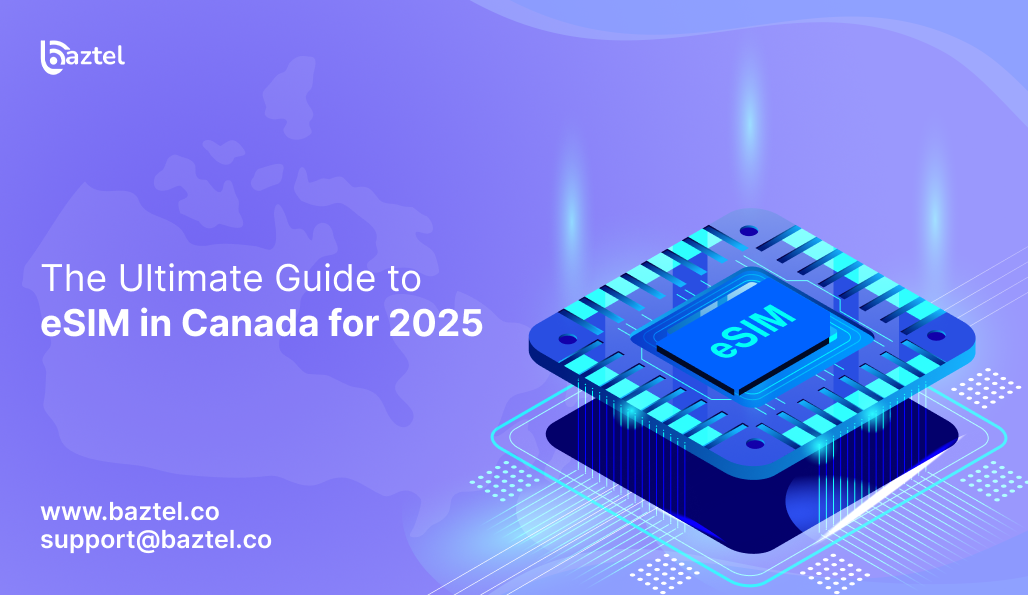Not everyone wants to land in a new country and start hunting for SIM cards. Especially in Canada. You may reach late. Airport stores might be closed. Some shops may even ask for ID. That’s where eSIM Canada comes in. It’s a digital SIM. No physical card. You just scan and connect. It saves time. No queues. No tiny SIM tools. Just open your phone and activate the plan. Whether you’re coming for business or holiday, most travellers now use eSIM. It works on newer phones like iPhones, Pixels, and many Android models. Plus, top brands like Baztel offer Canada-specific eSIM plans. You can even install it before your flight. If you still use plastic SIMs in 2025, this ultimate guide will change your mind. Learn what an eSIM is if you’re hearing the term for the first time.
How eSIM Differs from Physical SIM Cards
Still carrying a SIM ejector pin while travelling? Still checking if the SIM fits in your slot? Still waiting in line at airport shops just to buy a chip? That’s the problem with physical SIM cards in 2025. They’re slow. They’re manual. They’re outdated. Now compare that with an eSIM Canada plan. You don’t open your SIM tray. You don’t swap anything. You don’t visit any store. You just scan a code. Plans are added. Done in under 5 minutes. Even if you switch phones or travel from the US to Canada, your eSIM doesn’t get lost. It stays in your account. Some providers even let you re-download it. With physical SIMs, if your phone breaks or gets stolen, you lose your number. With eSIM, you just log in again and restore your plan.
eSIM is not just convenient, it’s safer. No SIM slot means one less point of hardware failure. No physical card also means no more plastic waste. And with Canadian networks now supporting eSIM across most regions, it’s already replacing the old chip. Want a full breakdown? Here’s a SIM vs eSIM comparison you’ll understand in 2 minutes
Why Travellers Need an eSIM Canada Guide in 2025
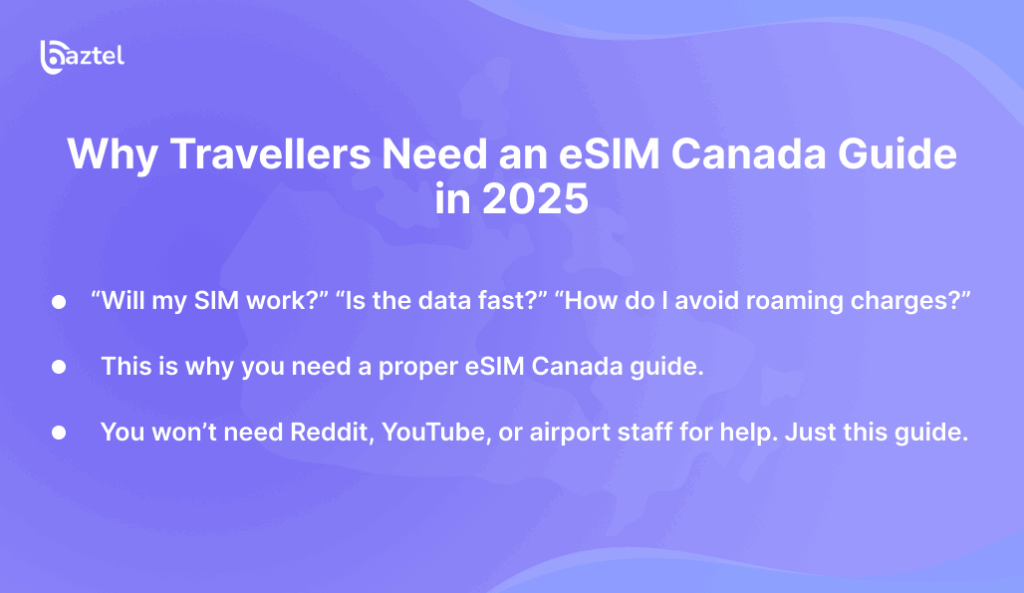
Every tourist landing in Canada has the same 3 worries:
“Will my SIM work?” “Is the data fast?” “How do I avoid roaming charges?”
Most assume they’ll figure it out after arrival. That’s where the problem starts.
Airport SIM counters are either shut, overpriced, or out of stock. Public Wi-Fi is weak or crowded. And your home SIM? It starts eating into roaming charges the minute you switch off airplane mode.
This is why you need a proper eSIM Canada ultimate guide.
Not all eSIM plans work the same. Some have limited coverage in rural areas. Some charge for setup. Some offer great data but no call or text support.
If you’re heading to places like Banff, Whistler, or even downtown Toronto, you’ll need different kinds of plans based on usage, duration, and network.
This ultimate guide simplifies it.
From choosing the best data eSIM plans Canada to checking device compatibility everything is sorted here.
You won’t need Reddit, YouTube, or airport staff for help. Just this ultimate guide.
Bonus: We’ve also included step-by-step eSIM setup tutorials for iPhone and Android.
Is Your Phone Ready for eSIM in Canada?
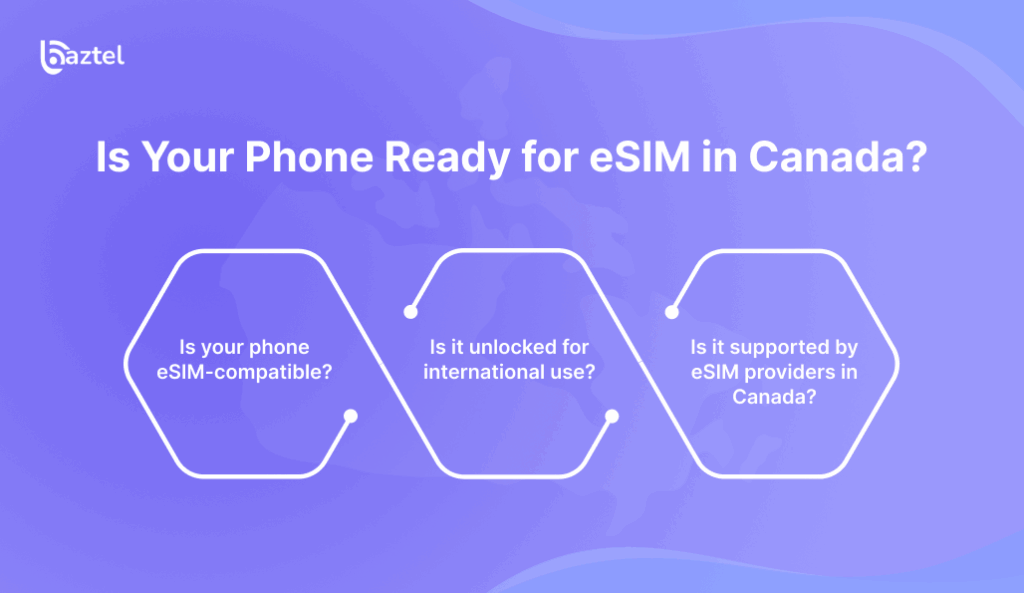
Not all phones are ready for eSIM in Canada. And that’s the first thing most travellers miss.
Just because your phone supports eSIM doesn’t mean it’ll work with every provider here. Some Canadian networks reject phones that aren’t officially carrier-unlocked. Others have limited compatibility with older devices or China-imported models.
Before you even think about scanning a QR code, you need to check 3 things:
- Is your phone eSIM-compatible? Most recent iPhones (from XR onwards), Google Pixels (Pixel 3+), and high-end Samsung models support eSIM.
- Is it unlocked for international use? If you bought your phone via a carrier contract (especially in the US), it might be locked. eSIMs won’t work until it’s unlocked.
- Is it supported by eSIM providers in Canada? Some eSIM providers (like Baztel, Airalo, or Holafly) clearly list supported models. Always double-check their list before purchasing.
If you ignore this step, you might end up buying an eSIM plan that simply refuses to install. Even worse, some phones allow scanning but don’t activate the data unless all network checks pass.
Pro Tip: Check this full compatibility list before buying your plan.
eSIM Compatibility for iPhone, Android, and Pixel
If you’re planning to buy an eSIM in Canada, don’t assume every smartphone will support it, especially when switching networks abroad.
iPhone Models That Support eSIM in Canada
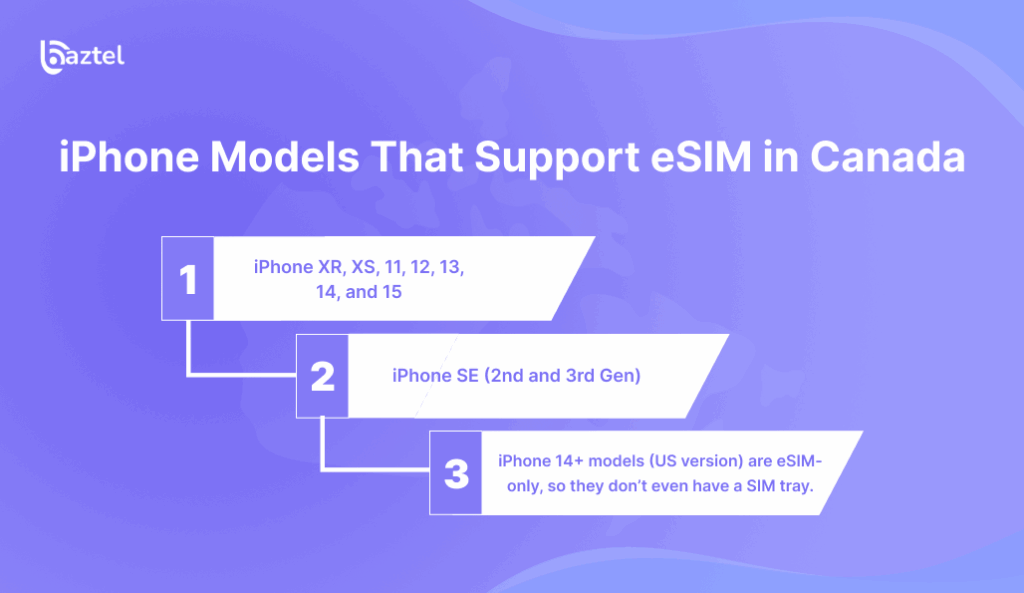
Most iPhones sold after 2018 support eSIM. But Canadian carriers (and eSIM brands like Baztel or Airalo) usually support models starting from iPhone XR and above.
Here are the most stable models for eSIM use in Canada:
- iPhone XR, XS, 11, 12, 13, 14, and 15
- iPhone SE (2nd and 3rd Gen)
- iPhone 14+ models (US version) are eSIM-only, so they don’t even have a SIM tray.
But remember, your iPhone must be unlocked. If it was bought on contract, check with your home carrier before trying to use an eSIM here.
Android Phones with eSIM Support in Canada
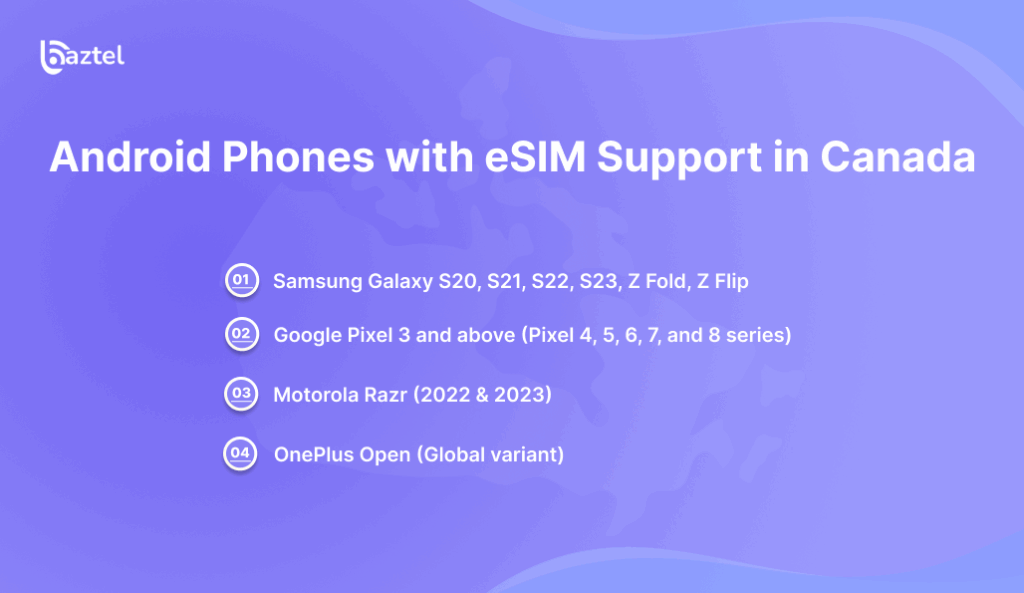
This is where it gets tricky. Not all Android phones are built equal when it comes to eSIM.
Some phones support eSIM only in certain countries, while others need specific firmware updates.
Phones that work well with eSIM Canada plans:
- Samsung Galaxy S20, S21, S22, S23, Z Fold, Z Flip
- Google Pixel 3 and above (Pixel 4, 5, 6, 7, and 8 series)
- Motorola Razr (2022 & 2023)
- OnePlus Open (Global variant)
Avoid Chinese-imported Android models. Even if the phone has an eSIM setting, it might not activate on Canadian networks.
Google Pixel Users You’re in Luck
If you’re using a Google Pixel, you’re in the safest zone. Pixels have the best track record when it comes to international eSIM switching.
Google Pixel 4a, 5, 6, 7, 8 and Fold versions all support eSIM in Canada as long as the phone is unlocked and on the latest Android version.
Quick Test: On your phone, go to Settings > Network & Internet > SIMs. If you see “Download SIM” or “Add eSIM,” your device is compatible.
Alternatives if Your Device Doesn’t Support eSIM
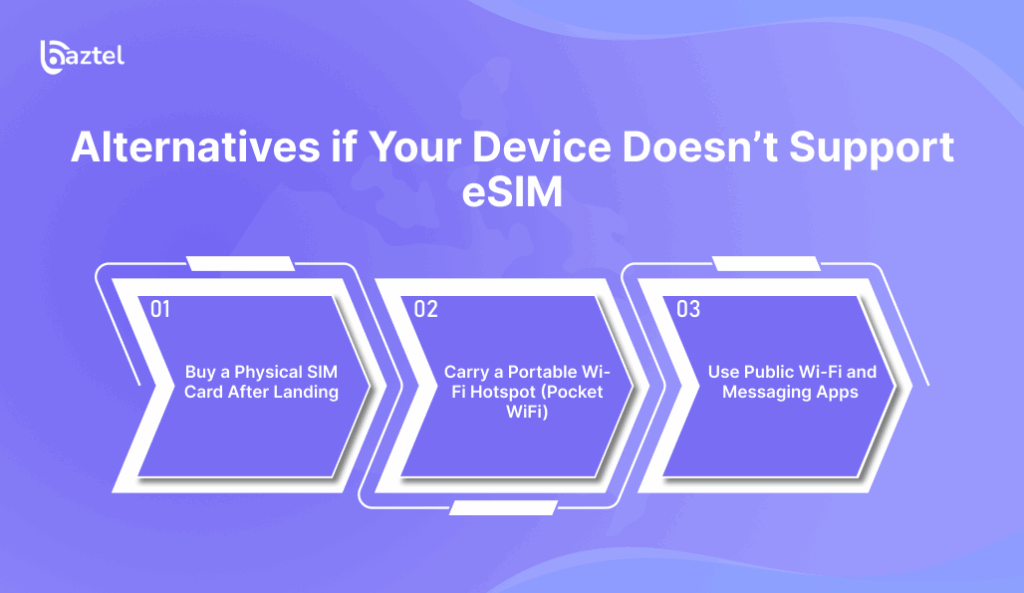
Not all phones support eSIM, especially older Android models, low-budget phones, or locked devices bought on EMI. But that doesn’t mean you’re stuck with expensive roaming in Canada.
There are 3 solid alternatives you can try instead of an eSIM.
1. Buy a Physical SIM Card After Landing
If your phone only supports regular SIM cards, you can buy one from a Canadian store like:
- 7-Eleven
- Walmart
- Best Buy
- Local carrier outlets like Rogers, Telus, or Bell
These shops usually sell prepaid SIM cards with limited data packs. But setup may take time, especially if they ask for passport ID or address proof.
Prices also vary depending on city and brand. In smaller towns or national parks, finding a store can get tricky.
Good for: Long stays, budget phones, and if you’re okay waiting a few hours after arrival.
2. Carry a Portable Wi-Fi Hotspot (Pocket WiFi)
Some travellers prefer Pocket WiFi over SIM cards. It’s a small device that connects to Canadian networks and gives Wi-Fi to your phone.
Pros:
- Works with any phone, even SIM-locked models.
- Can be shared by multiple people.
Cons:
- Expensive rentals ($8–$12 per day)
- Needs to be charged separately
- No Canadian number or SMS option
Good for: Families or groups traveling together, or those who need Wi-Fi on multiple devices.
3. Use Public Wi-Fi and Messaging Apps
Not recommended for full trips, but in case you’re stuck without any SIM or hotspot:
- You can still use WhatsApp, Telegram, or FaceTime with hotel or café Wi-Fi.
- Use offline maps like Google Maps or Maps.me for directions.
- Download translation apps or restaurant menus before landing.
But don’t rely on public Wi-Fi if you’re planning to move around a lot. It’s patchy in national parks and rural areas.
Good for: Emergency backup, very short trips, or tight budgets.
Common Problems with Physical SIM Cards in Canada
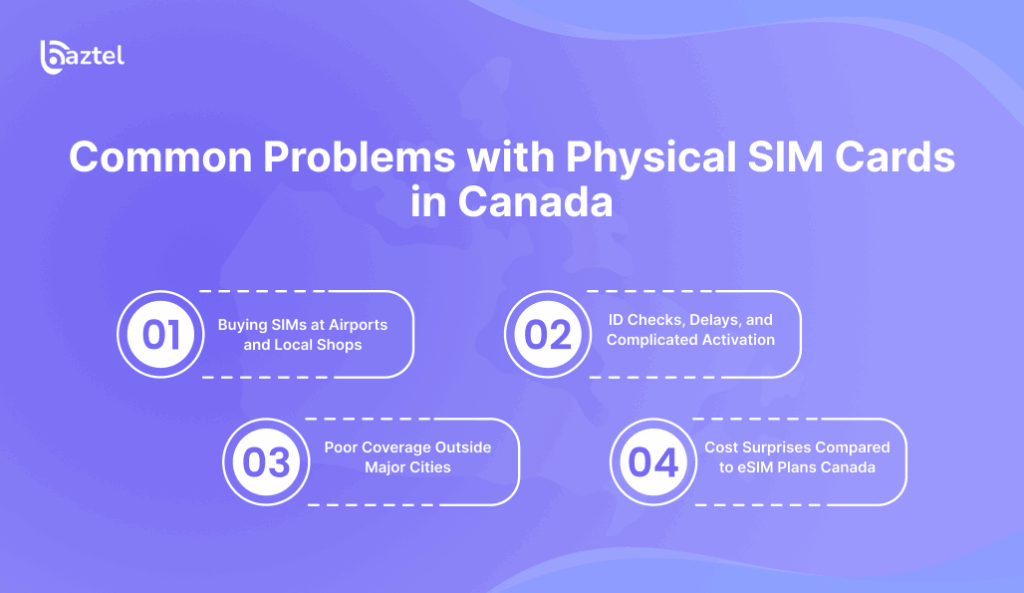
Buying a local SIM in Canada isn’t as simple as it sounds. Many travellers assume it’ll be quick and cheap, but the reality is often frustrating, especially in 2025. At Canadian airports like Toronto or Vancouver, SIM counters charge nearly double the usual price. What should cost around $20 ends up being $40 or more, and you may still face compatibility issues with your phone. If you skip the airport and try to buy from a local shop, you’ll either find limited stock or long queues and in smaller towns or remote areas, there might not be a store at all.
Buying SIMs at Airports and Local Shops
Many travellers think they’ll grab a SIM right after landing in Canada. But SIM card counters at airports like Toronto Pearson or Vancouver charge steep prices. A basic plan that should cost $20 ends up costing $40 or more. If you wait and try to find a shop in the city, you might face low stock, limited store hours, or long queues. And in remote towns, you may not find a SIM seller at all.
ID Checks, Delays, and Complicated Activation
Buying a SIM in Canada isn’t always instant. Many providers ask for a valid passport, sometimes a Canadian address, or even travel details. Some carriers delay activation by a few hours or more. And if your phone is still locked to your home network, it won’t support the new SIM. These steps confuse most tourists who expect plug-and-play connectivity.
Poor Coverage Outside Major Cities
Not all SIMs offer the same quality. Big carriers like Rogers or Bell work fine in cities. But budget providers like Freedom Mobile struggle in rural zones. If you’re planning to hike in Banff, drive through Saskatchewan, or visit national parks, you may end up with no signal. This is risky when using Google Maps, translation apps, or trying to call an Uber.
Cost Surprises Compared to eSIM Plans Canada
Physical SIM cards often come with surprise charges. What seems like an affordable plan might burn out your data quickly. Many prepaid SIMs in Canada have small data caps, and topping up isn’t always smooth. Auto-renewals can happen without clear alerts, and tourists get stuck paying for another month. Compared to that, eSIM plans especially from providers like Baztel show prices upfront and let you top up whenever you like.
Benefits of Choosing eSIM Canada for Tourists
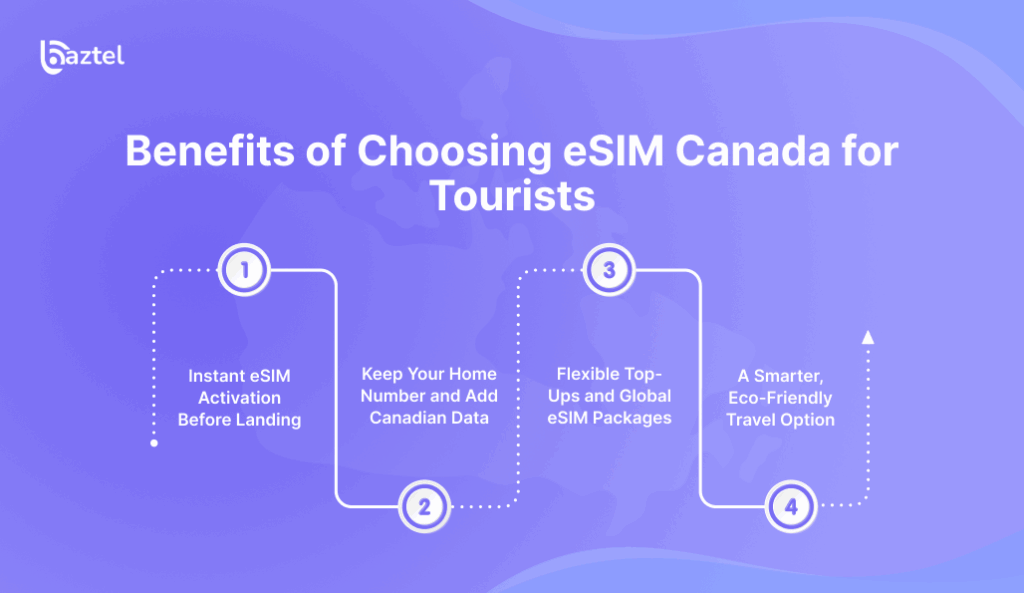
If you’re travelling to Canada in 2025, an eSIM is not just a tech upgrade it’s a smarter way to stay connected. It removes all the stress of buying SIMs at airports, waiting in lines, or figuring out carrier settings. With eSIM, you get instant setup, cheaper plans, and the comfort of staying online across Canada without touching a physical chip. And providers like Baztel now make this setup so simple, even non-tech travellers can activate within minutes.
Instant eSIM Activation Before Landing
With eSIM, you can set everything up even before your flight takes off. No standing in airport queues. No explaining your travel plan to a store clerk. You get a QR code from providers like Baztel, scan it, and you’re online the moment your flight touches down. For travellers heading straight to meetings, road trips, or remote stays, this makes a huge difference.
Keep Your Home Number and Add Canadian Data
eSIM lets you use two numbers at once. Your main number stays active for OTPs, bank alerts, or WhatsApp. At the same time, your Canadian eSIM gives you fast local data. This dual setup is super useful when you’re hopping between apps like Uber, Google Maps, or booking platforms. You won’t miss anything important from home.
Flexible Top-Ups and Global eSIM Packages
With traditional SIMs, topping up mid-trip can be frustrating. eSIM apps make this easier. You just open the app, pick a plan, pay, and it’s done. Baztel also offers global packages so if you’re heading to the US after Canada, you don’t need to switch providers. One eSIM, multiple countries, no physical card swaps.
A Smarter, Eco-Friendly Travel Option
Every time you buy a physical SIM, it comes with plastic packaging and waste. Multiply that by how often travellers change countries, and it’s a lot. eSIMs remove that entirely. No packaging, no plastic, no waste. It’s a cleaner way to stay connected, especially if you’re trying to reduce your travel footprint in 2025.
Best eSIM Plans Canada Has to Offer in 2025
In 2025, eSIM Canada plans are far more flexible and affordable than physical SIMs or roaming packs. Whether you need high-speed data for video calls or just basic browsing, there’s a plan for every type of traveller. You can choose from data-only packs, voice-enabled options, and even multi-country bundles all delivered digitally. And with platforms like Baztel, switching or upgrading is just a few taps away.
Data-Only vs Voice and Data eSIM Options
Some tourists only need data for maps, WhatsApp, and Google, no local number required. That’s where data-only eSIMs shine. They’re cheaper and cover all major cities like Toronto, Vancouver, and Montreal. But if you want to make local calls or receive job interview callbacks or tour bookings, choose a voice + data plan. Baztel, Airalo, and aloSIM offer both types, so you can pick what suits your trip.
Top Providers Offering eSIM Canada for Tourists
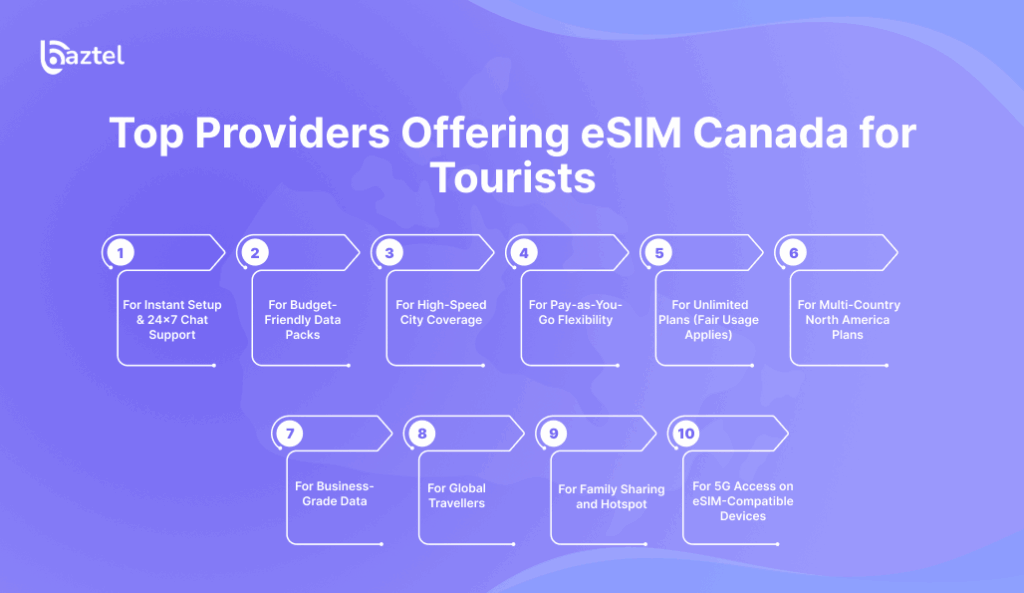
Finding the right eSIM Canada provider depends on your data needs and trip length. Here’s a quick guide based on Reddit feedback, real user reviews, and activation ease:
Baztel – For Instant Setup & 24×7 Chat Support
Perfect for first-time travellers who want a clean app and quick help anytime.
Airalo – For Budget-Friendly Data Packs
Offers ultra-low-cost eSIM plans Canada, ideal for short visits or low-data users.
Nomad – For High-Speed City Coverage
Delivers fast LTE in major cities and lets you pause or switch plans easily.
aloSIM – For Pay-as-You-Go Flexibility
Good for travellers who want to try eSIMs without committing to long plans.
Holafly – For Unlimited Plans (Fair Usage Applies)
Great if you stream a lot, though speeds might drop after certain usage.
Maya Mobile – For Multi-Country North America Plans
Best if you’re hopping between Canada, the US, and Mexico.
GigSky – For Business-Grade Data
Reliable for those working remotely with Zoom, Slack, and high-speed apps.
Flexiroam – For Global Travellers
Helpful if Canada is one stop in a longer international trip.
KeepGo – For Family Sharing and Hotspot
Supports multiple devices, handy if you’re travelling with family or a group.
Ubigi – For 5G Access on eSIM-Compatible Devices
Offers strong performance in cities with growing 5G networks.
Regional eSIM Canada Plans vs Global Packages
If you’re only visiting Canada, regional plans are the cheapest. They offer better speeds and coverage tailored to Canadian carriers. But if your trip includes the US, Mexico, or Europe later, consider a global eSIM package. Platforms like Baztel let you upgrade to a wider region without downloading a new QR or switching apps.
How to Install and Activate eSIM in Canada
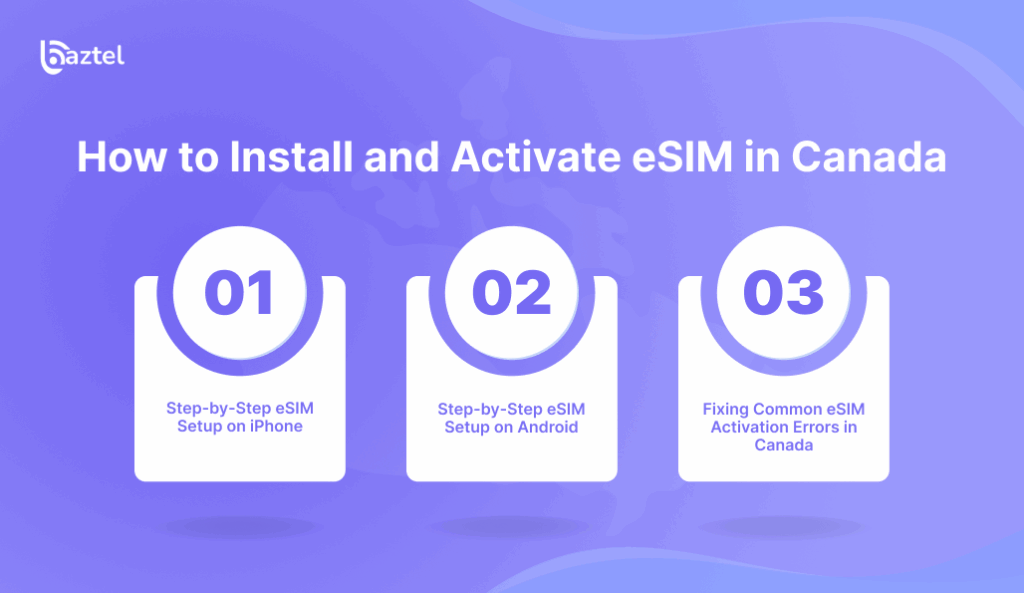
Getting started with eSIM in Canada is simpler than airport SIM counters. You don’t need to stand in queues, fill out ID forms, or visit a local shop. Once you pick a provider like Baztel, you’ll get a QR code or direct in-app option. You can install it before takeoff or after landing. Let’s go step-by-step.
Step-by-Step eSIM Setup on iPhone
Go to Settings → tap Mobile Data → choose Add eSIM.
Now scan the QR code you received from your provider. On iPhones, eSIM plans show up instantly after you confirm. Turn on data roaming (yes, you need this on for travel eSIMs), and you’ll live in Canada.
With providers like Baztel, you can skip the QR part. Their app supports direct eSIM installation, which is easier than figuring out roaming settings. If you want more help, this setup guide for iPhone eSIM explains every step with screenshots.
Step-by-Step eSIM Setup on Android
Open Settings → go to Connections or Network & Internet → tap Add eSIM.
Scan the QR code from your email or app. Follow the prompts. Once activated, check that mobile data is turned on. Baztel and other apps also support in-app activation for Android, useful if you lost the QR code.
If you’re unsure about device support, here’s a full eSIM compatibility checklist with all Android, iPhone, and Pixel models.
Fixing Common eSIM Activation Errors in Canada
Can’t see the plan? If you get “Profile Not Found,” your QR might expire. Don’t panic, most providers let you request a new one in-app.
No data even after setup? Go to APN settings and enter your provider’s APN (like globaldata or internet.baztel). Or try restarting your phone this solves most issues.
For Baztel users, help is one tap away. Their 24/7 eSIM support replies instantly no waiting hours for email replies or ticket numbers.
eSIM Canada Coverage by Region
Canada is huge. And when it comes to eSIM coverage, not all places are equal. If you’re staying in big cities like Toronto, Vancouver, or Calgary you’re covered. But heading to lakes, forests, or cross-border areas? Then you need to check which eSIM works where. Many travellers don’t realize that not all eSIMs work well in remote spots. Baztel, for example, uses local carrier tie-ups to offer stable signals even outside cities. Let’s break it down.
Ontario, British Columbia, and Alberta eSIM Performance
Most eSIM providers in Canada piggyback on networks like Rogers, Bell, or Telus. That means in urban areas like Toronto (Ontario), Vancouver (BC), and Calgary (Alberta) you’ll get 4G or even 5G speeds. If you’re using Baztel’s eSIM for Canada, it connects automatically to the best signal in each area. Speeds are fast enough for video calls, Google Maps, and Instagram uploads even during rush hours.
Staying Connected in Canadian National Parks
Travelling to Banff, Jasper, Whistler, or other remote areas? That’s where most SIMs struggle. Even top providers like Airalo or Nomad might give patchy coverage here. What you need is an eSIM that switches between towers. Some providers, including Baztel, use dynamic switching so even in low-signal zones, you stay online. But it’s still smart to download offline maps if you’re doing long hikes or road trips.
Using eSIM Across Canada and the US Border
Planning to cross over to New York, Seattle, or Detroit from Canada? Some eSIMs stop working at the border. Instead of buying two separate SIMs, just go for a Canada + US eSIM plan. Baztel, Nomad, and aloSIM offer combo plans that let you stay connected while crossing countries. This is a game changer for travellers doing road trips from Toronto to Niagara to Buffalo, or Vancouver to Seattle.
eSIM Canada vs Pocket WiFi and Roaming
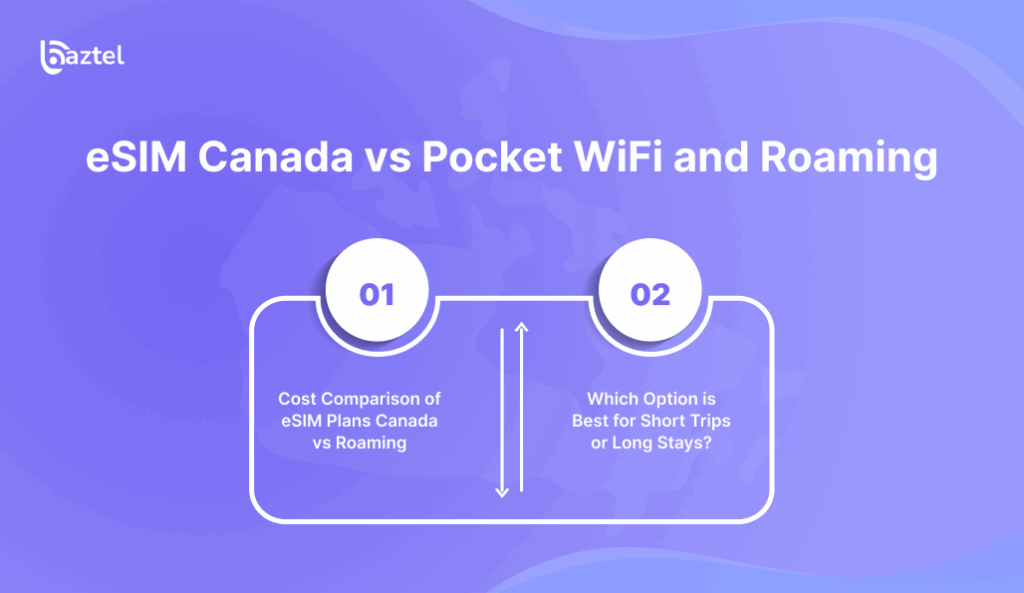
Confused between eSIM, Pocket WiFi, and international roaming? You’re not alone. Most tourists end up overpaying because they don’t understand what suits short trips, work calls, or off-grid travel. Roaming feels “safe” but gets expensive. Pocket WiFi needs charging and carrying around an extra box. And eSIM? It’s digital, lighter, and made for travel. But each one works better in different cases. Let’s compare real-time scenarios so you can choose what actually fits your trip.
Cost Comparison of eSIM Plans Canada vs Roaming
Roaming charges from your home SIM can quietly burn your money. Many users on Reddit shared how they got hit with surprise bills of $50–$150 for just checking maps and calling Uber. eSIMs avoid that. You choose your plan before landing. For example, Baztel’s Canada eSIM plans start under $5 for 1GB with no hidden charges. Even Airalo, Saily, or Nomad stay cheaper than any postpaid roaming.
Which Option is Best for Short Trips or Long Stays?
If you’re in Canada for a week or less, Pocket WiFi can work especially if you travel in a group and want to split the cost. But it only makes sense if you need unlimited data and carry it around all day. Long-term travellers or business users prefer eSIM. No pickup, no deposits, no extra device. It works directly on your phone. Plus, with Baztel’s eSIM, you can even switch plans mid-trip if needed.
Troubleshooting eSIM Canada Issues
Even digital SIMs can face hiccups. Some travelers land in Canada and expect instant connectivity but hit a roadblock. Maybe the QR code didn’t scan. Maybe the mobile data isn’t switching. The good news? Most eSIM issues are fixable in minutes if you know where to look. This section breaks down common problems and how to solve them like a pro.
What to Do if eSIM plans Canada Doesn’t Activate
First, double-check if your phone supports eSIM. Not all older models do. If it does, go to Settings > Mobile Network and look for “Add eSIM” or “Scan QR Code.” If activation fails, delete the profile and try re-adding it.
Still stuck? Many tourists find that roaming or VPN settings mess with setup. So turn off roaming, switch off VPNs, and make sure your phone’s date/time is correct. And always activate on Wi-Fi, not mobile data.
If you’re using Baztel, just open the app and go to “My eSIM Plans Canada” → “Support.” Their live chat team can reissue your QR instantly.
Fixing Coverage Drops or Data Problems
If data suddenly stops working in Canada, don’t panic. Open network settings and manually select a local carrier like Bell, Rogers, or Telus. eSIMs often pick a default automatically, but sometimes a manual switch improves speed.
Also, go to “Access Point Names” and check if the APN matches your provider’s settings. For Baztel, the correct APN is usually internet.baztel. One small typo there and your 5G won’t work.
How to Switch Between eSIM Plans Canada Easily
Planning to explore both eSIM Canada for tourists and the US? Or maybe hopping between cities with different coverage? You can store multiple eSIMs and toggle them in your settings. Just label them clearly like “Canada Trip” or “Toronto 5G” so you don’t mix them up.
To switch, go to Settings → Mobile Service → Tap the plan you want → Set it as Active. That’s it. With apps like Baztel, you don’t even need to scan again, just top up the plan and flip it on.
Final Verdict Why eSIM Canada is the Future of Travel
Travel is changing and so are SIM cards.
For years, travellers arriving in Canada had to queue up at airport kiosks, fill out forms, and pray their phone worked with a local SIM. Many still do. But with eSIM plans Canada now widely available, that struggle feels outdated. You no longer need to pop open your SIM tray or hunt for Wi-Fi just to get connected.
Instead, you can land with your plan already active ready to call an Uber, check maps, or text family. Platforms like Baztel let you activate your eSIM while you’re still at home. And if something goes wrong, help is a tap away.
From quick setup to flexible top-ups, eSIMs give you full control. Want data-only? Need a voice too? Travelling to the US next? It’s all in one digital profile. For tourists who value speed, simplicity, and peace of mind, eSIMs are not just convenient, they’re smarter.
So if you’re travelling to Canada in 2025, ask yourself:
Do you really want to waste time hunting for SIM cards… or would you rather be exploring the Rockies?
FAQs eSIM Canada Guide for 2025
Still got doubts? These are the questions real travellers ask before switching to an eSIM for Canada.
Which eSIM is best for Canada in 2025?
It depends on your needs. If you’re visiting for a short trip and want fast setup, providers like Baztel, Airalo, and Saily are all reliable. Baztel also offers a free trial, which many travellers use to test the network before paying.
Can I get a Canadian phone number with an eSIM?
Yes, but only with certain providers. Some data-only eSIMs won’t give you a local number. If you need one for calls, check if the provider includes voice plans with a Canadian number before purchase.
Should I activate my eSIM Canada plan before travel or after landing?
Always activate before traveling if possible. Most platforms let you scan the QR code and preload the plan. It stays dormant until you land, and then activates automatically when you connect to local networks.
Is an eSIM cheaper than roaming or buying a local SIM in Canada?
For most travellers, yes. eSIM plans usually cost less than roaming rates from your home provider. They also save time, no waiting at kiosks, no surprise fees, and you can top-up online anytime.
Can I use my US number or WhatsApp with a Canadian eSIM?
Absolutely. eSIM Canada for tourists only adds data or calls to your device; it doesn’t remove your existing number. You can still receive messages on your home number via WhatsApp or iMessage while using Canadian data from the eSIM.
Blog Author
Peter
Peter started BazTel.co to make mobile internet easier for travellers. He noticed how tough it was to find good network options while visiting new countries. That’s when he built BazTel — a place where anyone can buy eSIMs online without confusion or long steps. He believes tech should be simple and useful, not complicated. When he’s free, he likes to travel, test BazTel himself, and keep improving it based on real user problems.

 Botswana
Botswana Zambia
Zambia Congo
Congo Colombia
Colombia China mainland
China mainland Chile
Chile Chad
Chad Central African Republic
Central African Republic Canada
Canada Cameroon
Cameroon Cambodia
Cambodia Burkina Faso
Burkina Faso Bulgaria
Bulgaria Brunei Darussalam
Brunei Darussalam Brazil
Brazil Aland Islands
Aland Islands Bosnia and Herzegovina
Bosnia and Herzegovina Bolivia
Bolivia Belgium
Belgium Belarus
Belarus Bangladesh
Bangladesh Bahrain
Bahrain Azerbaijan
Azerbaijan Austria
Austria Australia
Australia Armenia
Armenia Argentina
Argentina Algeria
Algeria